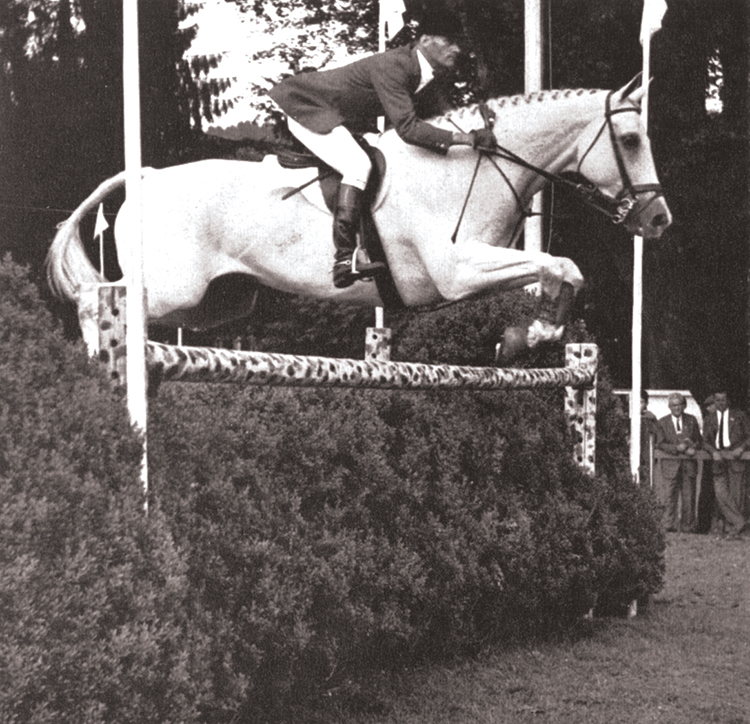
The first time I realised that riding could have a dimension of intellectual excitement came when I observed a William Steinkraus clinic at Art Uytendaal’s training stables back in early 1983. It was also the first time I realised that when interviewing Americans, the pen is a way too slow an instrument. Even with Roz gallantly trying to distract Mr Steinkraus as my biro battled to keep pace, there was no way I could completely capture the elegance of the visitor’s expression.
Steinkraus is not only a thinker, but a poet, though on this particular occasion, like poets and prophets the world over, his words fell largely on fallow ground – indeed his EFA ‘minder’ fell asleep during our interview… and I suspect that his concepts were way too subtle for the riders he was attempting to enlighten.
Even in Europe, Bill Steinkraus was considered a little too cultured to be an American!
Bertalan de Némethy remarked that: “Bill was a no-nonsense man. American riders respected him for his horsemanship, and the Europeans were surprised that someone as cultured, educated and intelligent could be an American rider!”
Bill Steinkraus’ message was dead simple really – good style is effective style. He told me back in 1983: “I hear people saying that a rider is ‘crude but effective’ but that is a contradiction. If someone is effective, then they are subtle. They don’t make their aids obvious because they don’t have to. The highest praise is to have someone say, ‘It looks as if the horse was doing it all by himself.’ All that means is that you have reached the stage where you can put every foot exactly where you want it, right around the course, you have arrived at the jump with exactly the right amount of impulsion, at exactly the angle you wanted, in the frame you wanted, and on exactly the right spot – the jump is inevitable.”
Little surprise, that Mr Steinkraus expressed just one regret even then, that he ‘didn’t retire a little earlier and go into dressage but I didn’t want to leave the showjumping team when I felt I still had a contribution to make.’
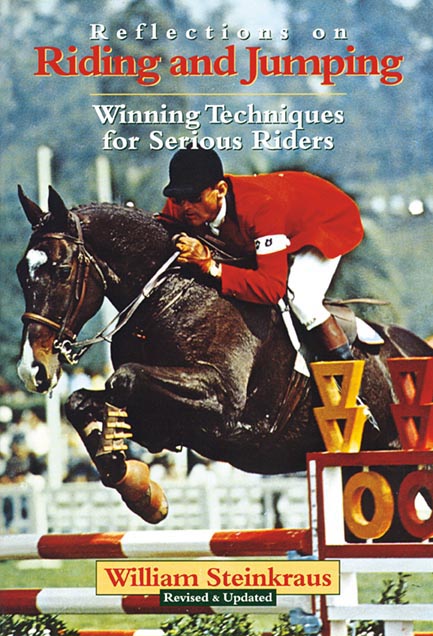
No surprise then to find in the revised and updated edition of his Reflections on Riding and Jumping – Winning Techniques for Serious Riders, that the intellect plays a crucial role in his philosophy:
“Rational riding starts with the idea that it’s easier to do something if you know very concretely what you’re trying to do, why you’re trying to do it and how it functions mechanically. ‘I can’t work that way,’ some riders protest. ‘It leads to paralysis through analysis.’ Well, that’s a good catch phrase, and it may even apply to some people, but there’s another famous aphorism that is just as catchy and twice as valid: Those who can’t learn from history are doomed to repeat it.”
Steinkraus recalls that as an ‘amateur’ rider, he had to commute between work and the US team training centre, but put the travelling time to good purpose, ‘on my way out there, planning what I was going to try to accomplish, and on the drive back, reviewing what had happened, and what I wanted to work on the next time. In those days, I thought this was a considerable disadvantage, and that I’d have been much more competitive if only I could have ridden every day. But in retrospect, I think it may even have been an advantage, for over the years I learned to make better and better use of my time on horseback, and was able to think out possible solutions to problems that might never have occurred to me spontaneously.”
In practical terms this means that “the key to a demanding Grand Prix jumper course is often a particular difficult line involving big fences, difficult distances, a combination and a turn that must be executed with great precision. Yet each of these elements can be isolated and mastered in simpler form in schooling long before we face them all together and in a more complex version during competition. For example, we can work out the line and the turn by using simple rails on the ground or cavalletti at the trot and canter; we can work out the distance problems of the combination through cavalletti and gymnastic grids. And when we put all these ingredients back together at speed over big fences, we can handle the problem instead of being overwhelmed by its difficulty and complexity.”
You can imagine how Mr Steinkraus was received in Australia a quarter of a century ago, when he suggested that getting over the jumps was not the challenge, what was interesting was the ability – or lack of it – to smoothly canter the ‘course’ without the jumps!
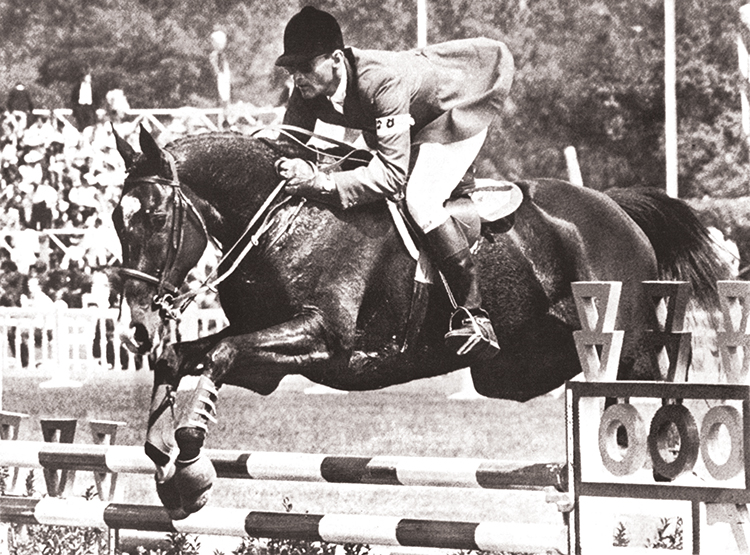
A gold medal at Mexico for Bill Steinkraus and Snowbound. This horse was one of a series of brilliant Thoroughbreds that took Steinkraus to international success – he was by Hail Victory out of a mare by Gay World. Snowbound joined the US team in 1964 and was still winning international classes in Europe seven years later!
Twenty two years ago, he told Australian jumping riders: “We start with problems on the flat and solve them on the flat. For until the problems on the flat are solved, the problems over fences are not all that interesting. What a horse can do out of self-defence over a fence is only a fraction of his true ability if he still has a problem on the flat.”
As usual with American equestrian experts, Mr Steinkraus is a stickler for detail, and his book covers everything from gloves – ‘avoid extremes… gloves should either have their seams turned in where the reins go, be protected by an additional layer, or both’ – to saddles. Naturally, Steinkraus prefers the Hermès saddle after all, he designed it for the company, but luckily for riders without the wherewithal for the boutique option he does specify what should be looked for:
“It is essential that the lowest point in the seat is halfway between the pommel and the cantle and not further back, which makes you feel as if you’re always riding slightly uphill; the head or pommel must not press against the top of the withers of a horse of average conformation (if it does, it’s more often because the tree is spread than because of bad original design, but I’ve seen the latter, too); flaps and skirts must be heavy enough to resist folding or curling up under your leg; finally, the stirrup bars must hold the stirrup leathers securely with the safety latch open (and it should never be closed!).”
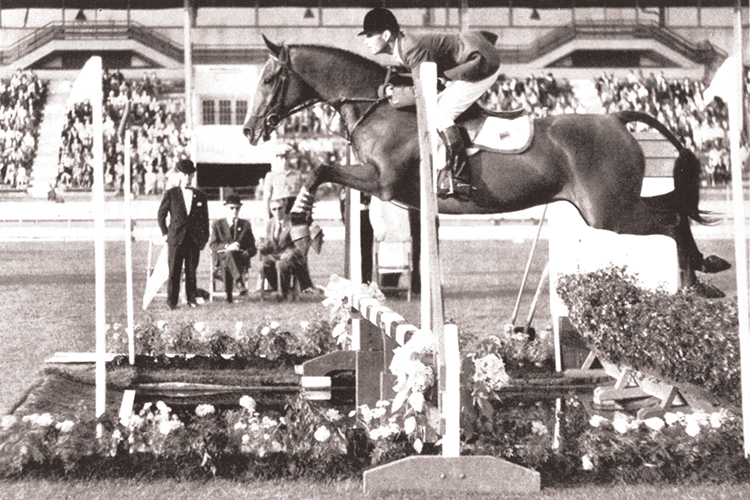
Bill Steinkraus and Sinjon, winning The Country Life and Riding Cup in London, 1962. Sinjon was a member of the US team from 1958 to 1964
And why is Bill Steinkraus fussy about his saddle?
Because he is fanatical about rider position – and why? “Because the kind of riding I’m talking about is more than simply staying on. It inevitably involves the education and development of the horse, and this is accomplished through our aids – our body language – by eliciting and rewarding the behaviour we want, and by resisting and blocking the behaviour we do not want. And in order to resist, sustain and reward effectively, our aids must be totally independent of the business of staying on, and they must function from a stable platform. That platform is our position, or more precisely, those positions that facilitate the instrumental acts we require.”
Story continues below the advertisement
Breeding a showjumper? There’s a range of top European blood lines available in Australia. Go to www.ihb.com.au
Stallions like Diacontinius and many more:
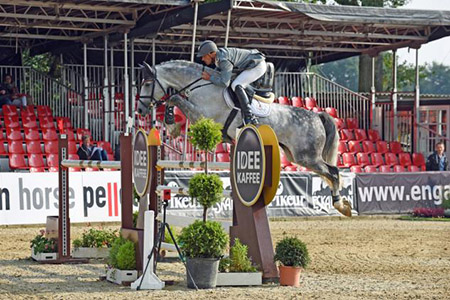
The concept of positions plural is important. Steinkraus explains that the seat is a spectrum, from the defensive ‘safety’ seat to the ‘highly permissive, extreme forward seat’ and sitting in the middle is ‘the median seat’. But moving to the extremes is cautioned against:
“I hasten to add that having a whole collection of seats, including some extreme ones, doesn’t mean that you use all of them every day. Quite the contrary! In fact, if we arbitrarily say that the median seat is situated at 5.0 on a scale from 0 to 10, most of your riding will be in the area from 4.8 to 5.2 and only rarely make an excursion into something more extreme.”
The median seat is not only in the middle of this spectrum, it is also the position in which the rider’s joints and muscles are in a median position – ‘halfway between the extremes of full extension and complete flexion. In this neutral position, they not only enjoy maximum elasticity, but at the same time can move very readily in either direction.’
While the heel must be deeper than the toe (this is America) Steinkraus warns against an exaggeratedly deep heel:
“It’s important to remember that even a virtue, carried to excess, may become a sin. So it is with the deep heel. If the heel is forced as low as it will go, the ankle will be frozen shut, no longer able to function as a spring; while the calf in full extension loses its elasticity and becomes impossible for a sensitive horse to accept. (Some teachers and equitation judges cannot imagine too deep a heel, but I still regard it as functionally wrong.) The toe should turn out only to the extent that it normally does in walking.”

Jumping at Lucerne in 1960 – Bill Steinkraus and Riviera Wonder. Yet another jumping Thoroughbred, this time by Bonne Nuit out of Winter Rose who was the dam of another US team horse, Unusual. Riviera Wonder was on the silver medal winning team at the Rome Games.
Moving up the rider’s leg: “The bottom of the calf should be applied to the little triangle of the horse’s side just behind the girth and just below the saddle flap, if the rider’s leg is long enough. Ideally, this is the place where you add or subtract calf pressure in order to modulate your driving aids. If you like to think of having a bolt driven through your legs to create a secure, stable seat, that is where you should visualize it, and not through the knee. If you do so, you will never pinch with the knee, and never have a problem in posting too high or assuming too high a half-seat. (I prefer the term ‘half-seat’ for what is sometimes called a ‘two-point’ position). When the heel is not excessively deep, the calf itself will be elastic and clinging. Levelling the foot more makes it even softer for horses that try to reject the leg. Dropping the heel hardens the calf as needed in emergencies or for drive.”
But it is not only the lower leg:
“Perhaps the crucial point in dealing with the rider’s seat is the attitude of the back or spinal column. You must be able to release your back vertically, so it can swing freely with the horse’s back, and you also must be able to stress or brace it readily.”
Once the back is right, the head follows: “If the shoulders are comfortably drawn back (never rounded or hunched forward), the head will naturally be free, easy and erect as well. The eyes should be focused on where you’re going, a simple thing that seems to help coordinate all of the rider’s actions on horseback.”
Legs are crucial but so are arms:
“What must the hand and arm be able to do? Yield, sustain, resist. What they do not need to do is pull, because no rider has ever won a pulling contest with a horse. In order to sustain and resist, the hands must be supported from the rider’s elastically braced back and, to the necessary degree, from the support of the upper arm against the side.”
Want to know why the dreaded ‘eventer’s elbow’ – that unsightly triangle so many eventing riders make with their elbows out and pointed sideways – is not only ugly but dysfunctional?
Let Mr Steinkraus explain: “the position of the rider’s arms with flat hands and an extended elbow (is) such an impediment to a good rider. The fact that the hands are forced forward and low, rounds the rider’s shoulders, pulls his buttocks out of the saddle and shifts his weight too far forward; the fact that the elbow is extended robs him of the use of that joint as a means of insulating the hands from the movement of the upper body (in the posting trot, for example) and encourages him both to pull and rest his hands on the horse’s mouth. ‘You must make a contract with your horse,’ Commander Licart of the Cadre Noir liked to say. ‘He carries his head, and you carry your hands.’ And contrary to the old instructor’s maxim, a vertical line dropped from the rider’s head and passing through his hips will fall somewhat behind the heel, which is not only acceptable, but correct.”
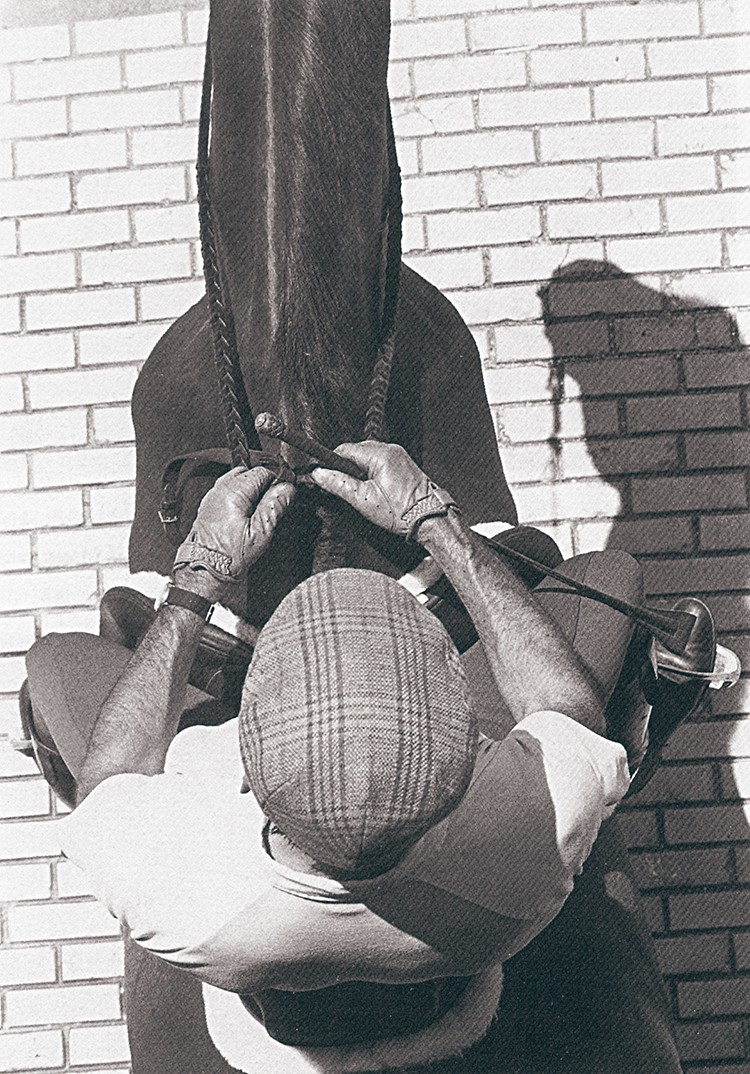
Normal hands, and the normal way of holding a whip, as seen from above. Notice how the whip rests against the rider’s upper leg. Photo – Alix Coleman from Reflections on Riding and Jumping.
Like George Morris, William Steinkraus absorbed the dual influences of the French school through the US Army, and the German thinking of the post War era, headed up by Bertalan de Némethy. He has an interesting slant on reconciling the two:
“German equestrian literature and much German teaching suggest that the hands should do no more than hold the reins, and that you should influence the horse almost entirely through your legs. The French, on the other hand, describe a wide variety of different rein effects and attach great importance to them, while acknowledging the importance of always supporting and coordinating them with the actions of the legs. The contradiction may be more apparent than real, because the best German riders use their hands a lot, even though their basic methods tend to presuppose the German type of horse that has less natural impulsion (therefore requiring stronger leg actions) than the Anglo-Arab and Selle Français strains preferred by the French, or the Anglo-American Thoroughbred. Having learned a lot from studying both approaches, I do not consider them impossible to reconcile. Good hands will be stable (rather than unsteady); interesting (rather than boring or stupid); refined (rather than crude or clumsy); and fair (rather than arbitrary or punitive).”
One thing William Steinkraus keeps from the French tradition is the dictum that once the horse is doing what you want it to do, you stop doing anything:
“I cannot stress too much the vital importance of restoring all aids to their normal state as soon as the horse has complied with them. Once the horse has gone forward, ease up on your driving aids; once it has shortened, open your fingers again enough to reward. It is very common to see exactly the opposite: the rider gets the horse to come back once, but never releases his closed fingers again, and spends the rest of the hour hanging in the horse’s mouth, or, having gotten the horse to go forward, spends the rest of the day with his legs stuck halfway through the horse. The reason you want your aids to be effective is so that you can teach the horse to respond to them more and more sensitively – and so that you can use them less and less. The old expression ‘crude but effective’ is thus a contradiction in terms as applied to riding; means aids that are truly effective are also economical, and economy is essentially attractive and never crude.”
Once again, in this philosophy, everything connects, flows through – or vice versa: “Let me emphasize again how essential a correct position of the hands, arms and shoulders is to the correct functioning of the hands. There can be no effective resistance if the hands are flat and the rider’s elbows cannot find support against his sides. Nor can there be light, elastic contact with the horse’s mouth if the rider’s elbow joints are locked in a position from which they cannot freely open and close. Flat hands that are forced low doom the rider to mediocrity, even though some teachers and even judges may consider them acceptable.”
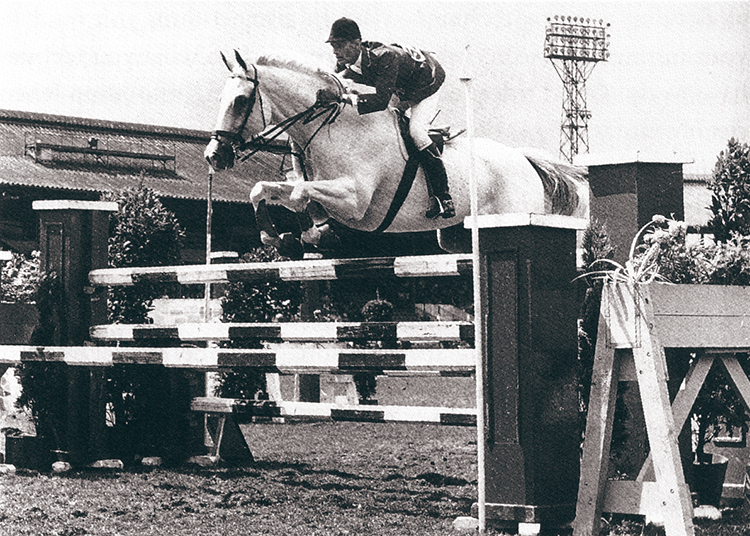 In a perfect jump, the rider should feel that he does nothing at all in the way of jumping or trying to ‘lift’the horse off the ground when the horse jumps. He should simply sit in the middle of the horse and let the horse fold him up, while trying to maintain the same contact with the horse’s mouth in the air that he had leaving the ground. Here on Riviera Wonder Photo – Peter Winants from Reflections on Riding and Jumping.
In a perfect jump, the rider should feel that he does nothing at all in the way of jumping or trying to ‘lift’the horse off the ground when the horse jumps. He should simply sit in the middle of the horse and let the horse fold him up, while trying to maintain the same contact with the horse’s mouth in the air that he had leaving the ground. Here on Riviera Wonder Photo – Peter Winants from Reflections on Riding and Jumping.
Think about all the riders you see with their lower legs way back and pressing against the horse, simply because those riders haven’t got their horse ‘on the aids’. Count the number of times you see a rider trying to execute shoulder in, with their inside leg ten centimetres behind the girth, in other words, with their inside leg in the position their outside leg should be. They should all memorize Mr Steinkraus’ advice:
“The progression of escalating aids goes like this: light added calf pressure; stronger added calf pressure; touch with the heel; touch with the spur; hard punch with the spur. If nothing is happening at this point, reinforce the leg with the whip… Note that the leg does not normally move back to become active, except when it is being used as a lateral aid of some kind. In fact, if anything, the opposite should be true, but the further back the leg goes, the weaker its position. Sometimes, when you really need a very strong leg in an emergency, it’s a good idea to reach back softly with both legs and then bring them very vigorously forward, thus finishing in a strong position instead of a weak one. Many riders, especially in dressage, get into the habit of constantly tapping with their legs or spurs, believing that they’re doing the horse a favour by supporting its forward movement. What they are really doing, however, is telling it: ‘Ignore my leg – it will go on tapping, no matter what you do, so you may as well pretend it isn’t there.’”
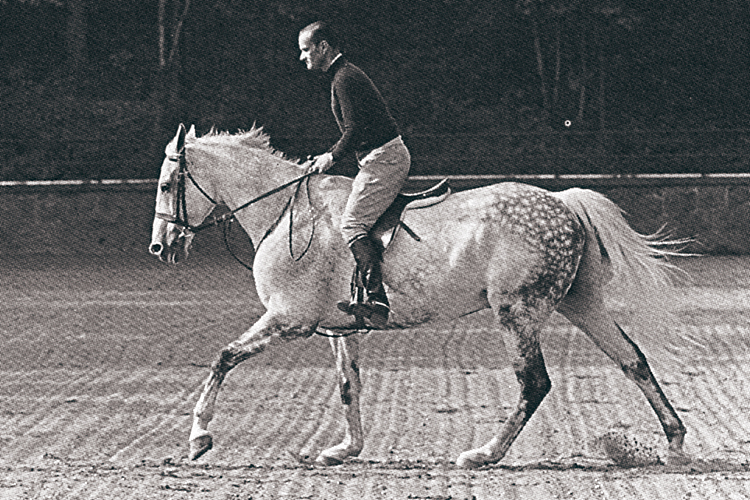
For anything beyond a strong canter, the rider will usually prefer a half-seat. If he is sitting in balance, there should be no need to rest his hands on the horse’s neck, but in either case, the half-seat should be clean, with no posting to the canter. Photo – Peter Winants from Reflections on Riding and Jumping.
Now to that crucial yet much neglected aid – the back:
“The back is the most difficult and even controversial aid to try to pin down, yet it is also the most critical one, and can exert a decisive influence on the other natural aids in both positive and negative ways. The key to the correct action of the back is variable elasticity, and the horse will tell you when the action is correct and when it is wrong. When it is correct, you are able to use less and less hand and leg until the horse seems to read your thoughts and respond to your back alone. When it is wrong, neither hand nor leg seems to have any real influence, and it takes a big effort to produce any response at all.”
Story continues below the advertisement
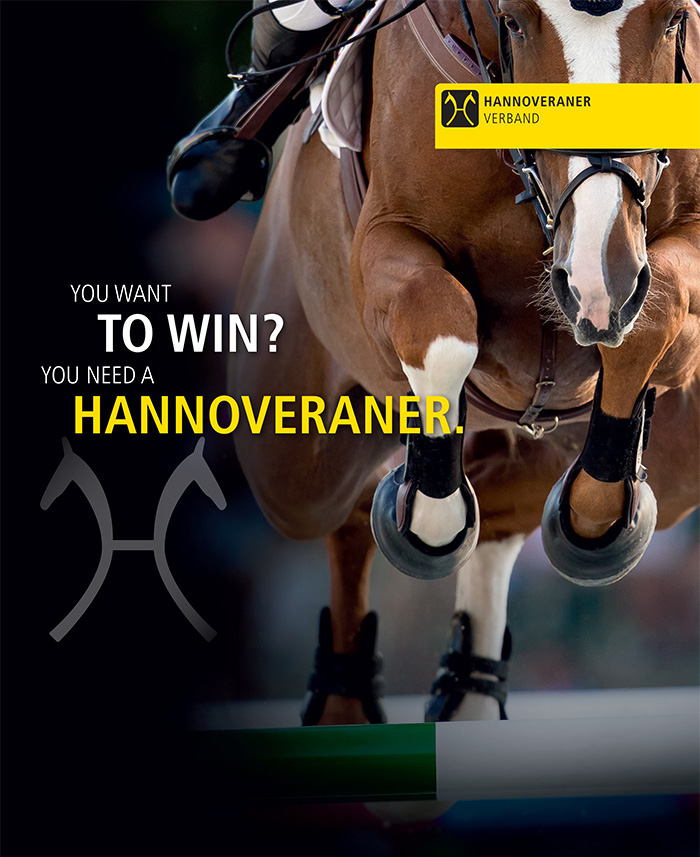
I can remember the German trained American dressage rider, Lisa Wilcox telling me how important the stomach was in her riding technique, and interestingly, Bill Steinkraus’ use of the ‘back’ also seems to involve the stomach: “First I stretch up slightly, tightening my abdominal muscles as well as those that support the lower spine; then I push everything below the waist a bit forward, while drawing the shoulders and everything above the waist slightly back. It helps if the rider takes a deep breath before starting to use the back, for this by itself tends to make you sit taller and expands your chest while supporting the small of the back.”
Once again, over-use the aid and you end up in trouble:
“Once a rider discovers that he can influence the horse with his back he often becomes so intoxicated with the effect that he insists of continually ‘coming through’ with it, and forgets ever to reward the horse. This eventually teaches horses to defend themselves, and some learn this lesson all too well. Trying to reform a horse that has learned to stiffen its back as a defence against the rider’s rigid seat and back can be a daunting task. And sad to say, many fine riders have ended their years with serious back problems that originated, I suspect, in trying to make too much of a good thing. Once you learn to use the back, try to refine your use of this wonderful aid by seeing how little of it you can get by with instead of how much, and encourage the horse to release its back by letting yours swing with it as often as you can.”
And don’t forget the voice:
“Every rider should also have a ‘cluck’ that works on every horse. When I give a loud cluck, I want my horses to move forward immediately. It’s easy to train them to do this simply by clucking and hitting them with a stick at the same time until the desired response is there, and then refreshing their memory from time to time. The beauty of a cluck is that, like ‘whoa’ it can be used in varying intensities, and without changing the other aids.”
In Australia, Bill Steinkraus would return over and over to musical metaphors. Trotting over a rail on the ground was like playing a C major scale on the violin, to do it very perfectly with a beautiful tone is both very simple and very difficult.
“Trotting poles are the building block for the whole of the horse’s life, not just an exercise. We are teaching the scale a note at a time, as it were, not expecting perfection at the beginning, but working towards perfections right from the beginning. We’ll go from the rails to gymnastic exercises, using grids, but at every stage we insist on the quality of performance not the height. If the style is there, and the foundation is solid, then height takes care of itself.”
It’s a philosophy of training that William Steinkraus absorbed from the great Bertalan de Némethy whose job it was to mould the ‘seat of their pants’ US riders into a team capable of handling European courses – and mixing it with the European teams.
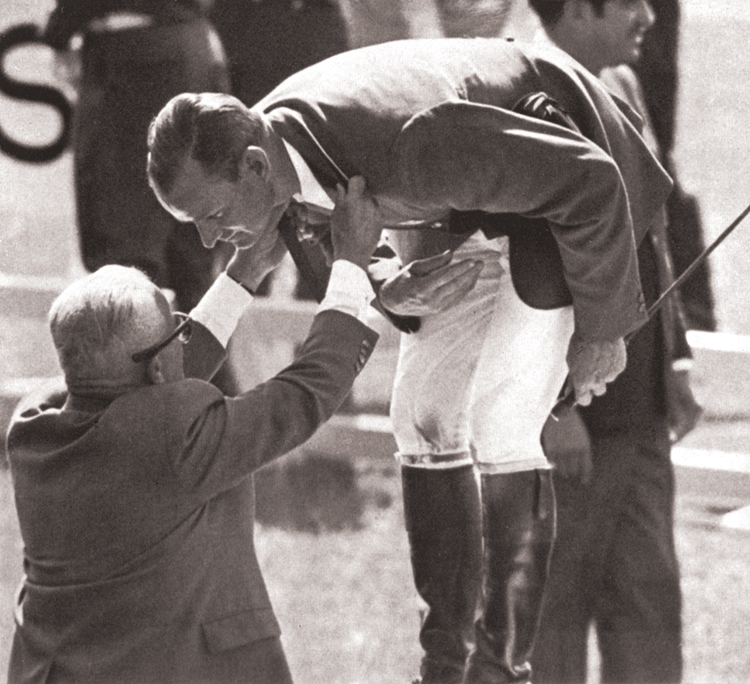
WILLAIM STEINKRAUS
He was the first American jumping rider to win an Olympic individual gold medal – at Mexico City in 1968! From 1951 through to 1972, Steinkraus was a key member of the US team, competing in six Olympics, sharing team bronze in 1952 and team silver in 1960 and 1972. William Steinkraus has also played a key administrative role in equestrian sport. He was elected president of the USET in 1973, became its chair in 1983, and Chairman Emeritus in 1992. A director of the American Horse Shows Association for more than four decades, he’s judged at the Olympics, Pan American Games, World Championships and World Cup finals. He served as the president of the World Cup Committee for ten years.
And yes, William Steinkraus is another to have won that stepping stone to American jumping greatness – the Maclay Medal at Madison Square Garden in 1941. Through all that, William Steinkraus never lost sight of the fact that there was more to the world than horses and jumps. As the former, USET rider, Hugh Wiley remarked: “He would think through a riding problem and always come up with an intelligent answer. After riding, he usually played his fiddle, read The Wall Street Journal or went to the opera.”
Sadly it would seem that Bill Steinkraus was another ‘missed opportunity’ for Australian jumping. Although on that 1983 visit to Australia he recognized that our riders were dealing with very much the same problems, from a shared heritage – and that we too rode Thoroughbreds – so far as I know, that clinic was a never to be repeated ‘one off’, how different the history of the sport might have been had he been persuaded to become a regular visitor to our shores…
FOUR SHOWJUMPING MASTERS – Part 1: George Morris


Wow. What an astute rider. This was a pleasure to read.